Finding halal options can be challenging when it comes to enjoying a delicious steak. Muslim consumers often struggle to find information about the different types of halal steak and their origins.
It’s frustrating to be limited in your culinary choices due to a lack of knowledge about halal steak options. Many wonder where they can find halal steaks that meet their dietary and religious requirements.
Discover the world of halal steaks with our comprehensive guide. We have curated a collection of different types of halal steak and their origins, giving you the information you need to make informed choices. From Angus beef sourced from Australia to Wagyu beef from Japan, explore the diverse range of halal steaks available. With our guide, you can confidently choose the perfect halal steak that suits your taste preferences and dietary needs.
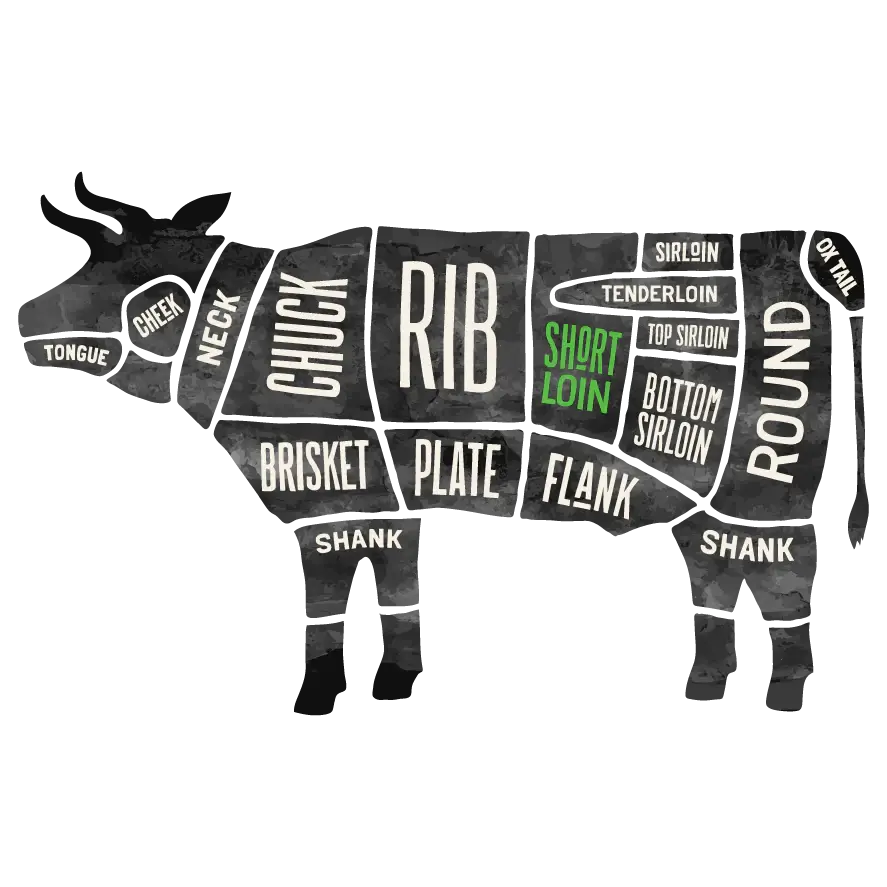
Not only will you learn about the various types of halal steaks available, but we will also provide insights into recommended cooking methods, seasonings, and accompaniments that will elevate your dining experience. Whether you prefer your steak grilled, pan-seared, or oven-baked, we will offer tips and tricks to ensure your halal steak is prepared to your desired level of doneness and delivers maximum flavour.
Suppose you are a halal food enthusiast, a steak lover, or simply curious about the halal-friendly culinary options available. In that case, this article will serve as your comprehensive guide to The 8 Different Types of Halal Steak. Prepare to tantalize your senses, broaden your steak knowledge, and savour the delectable flavours that await you in this remarkable world of halal cuisine!
The 8 Different Types of Halal Steak
1- Ribeye Hala Steak
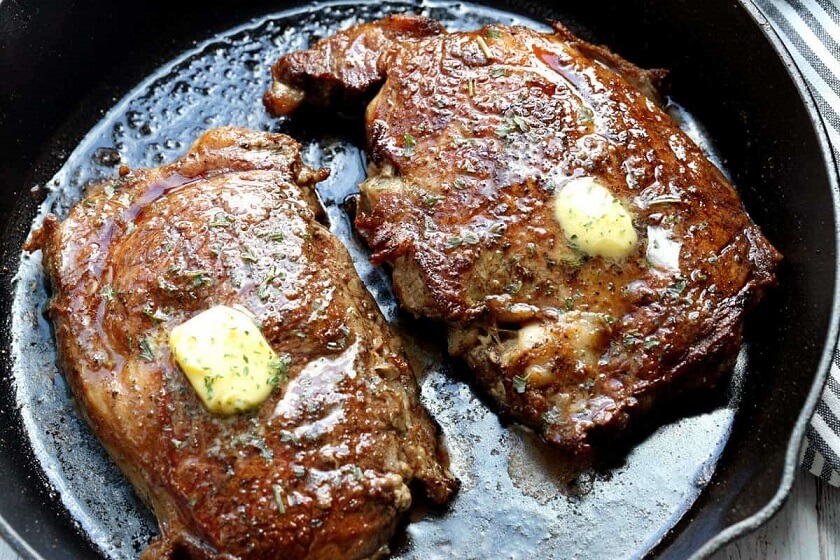
Originating from the United States, the steak is highly regarded for its juicy tenderness and rich marbling. Cut from the rib section of the beef, this halal steak boasts an intense flavour and remains a top choice for many steak enthusiasts. To cook a succulent Ribeye, sear it on high heat to lock in the flavours, then finish slow-roasting it in the oven to achieve the perfect medium-rare or medium doneness.
Ribeye steak is known for its rich marbling and intense flavour. Bring the meat to room temperature to cook a delicious halal ribeye steak. Season the steak generously with salt and pepper or your preferred spice blend. Heat a skillet or grill on medium-high heat and sear the steak for approximately 3-4 minutes on each side for medium-rare doneness. Allow the meat to rest for a few minutes before serving.
Ribeye steak is a trendy and mouthwatering cut of beef that meat enthusiasts worldwide love. It is known for its exceptional tenderness, rich marbling, and intense flavour, making it a go-to choice for steak lovers.
Derived from the rib section of a cow, specifically the rib primal, the ribeye steak is cut from the ribeye roll between the sixth and twelfth ribs. This particular animal region is less exercised, resulting in a beautifully tender, well-marbled piece of meat.
One of the standout features of ribeye steak is its abundant marbling, which refers to the white flecks of fat throughout the muscle tissue. This marbling contributes to the steak’s unmatched flavour and juiciness. The marbled fat melts as the heat cooks the Ribeye, releasing its natural flavours and enhancing the overall taste.
The ribeye steak is renowned for its robust, beefy flavour, often buttery or nutty. Additionally, the marbling ensures that the steak remains tender and juicy, even when cooked to medium or medium well. This makes it a versatile cut, suitable for various cooking methods, including grilling, broiling, pan-searing, or even sous vide.
Grilling a ribeye steak is a popular choice for its ability to create a delightful charred crust while leaving the meat tender and succulent. The grill’s high heat sears the exterior, sealing in the juices and creating a delicious smoky flavour. Pan-searing is another favoured method, using a hot skillet to cook the steak to the desired doneness quickly.
When it comes to seasoning a ribeye steak, simplicity often reigns supreme. A sprinkle of salt and pepper is often all needed to enhance the meat’s natural flavours. However, various herbs and spices like garlic, rosemary, or even a touch of paprika can be used to add depth and complexity.
Ribeye steak is usually served in generous cuts ranging from 1 to 2 inches thick. This thickness allows for a perfect balance between the seared exterior and the tender, juicy interior. Many steak enthusiasts prefer to cook ribeyes to medium rare or medium, ensuring a pink and succulent center while enjoying the intense flavours and texture.
Due to its exquisite taste and texture, ribeye steak is often considered a premium cut of beef, commanding a higher price than other cuts. However, its exceptional quality and the dining experience it offers to make it a favourite choice for special occasions, celebrations, or simply for indulging in a delicious, luxurious meal.
Whether enjoyed with traditional steak accompaniments like potatoes, vegetables, or a sauce of choice or as the centrepiece of a steak sandwich, the ribeye steak never fails to impress. Its flavorful, tender, and succulent qualities continue to make it one of the most sought-after cuts of beef by meat lovers worldwide.
2- Sirloin Halal Steak
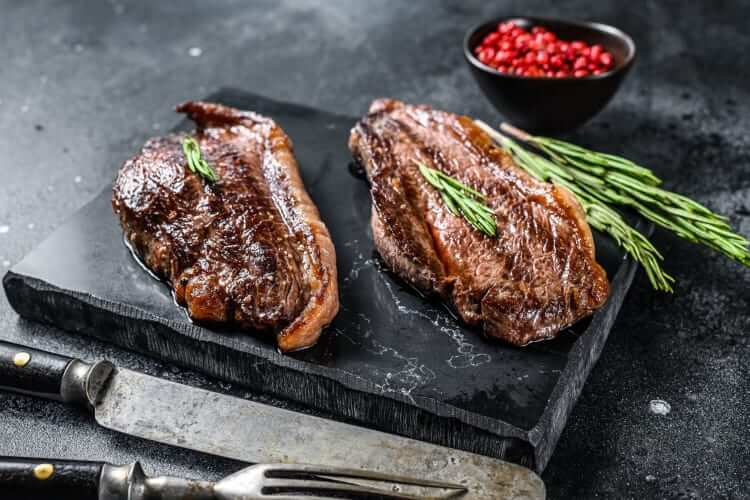
Hailing from Britain, the Sirloin steak is renowned for its balance of flavour and tenderness. This halal cut is obtained from the upper middle of the cow, featuring a strip of fat that enhances its taste. Preparing Sirloin steak involves marinating it to infuse flavours and then grilling it to your desired level of doneness.
Sirloin steak is a versatile and flavorful cut that can be enjoyed using various cooking techniques. Season the steak with salt, pepper, and any preferred spices. Heat a skillet or grill over medium-high heat. Cook the steak for around 4-5 minutes per side for medium-rare. Allow the meat to rest before slicing and serving.
Sirloin steak is a popular and delicious cut of beef known for its tenderness, bold flavour, and versatility in cooking. Derived from the rear back portion of a cow, this steak is highly valued due to its optimal balance of marbling and leanness, resulting in juicy, flavorful meat.
One of the distinguishing features of sirloin steak is the presence of a layer of fat that runs along one side. This fat, termed “fat cap,” not only adds flavour but also helps maintain the tenderness and juiciness of the meat during the cooking process. The marbling within the beef further contributes to its juiciness, allowing the fat to melt during cooking and infusing the steak with rich flavours.
Sirloin steak is known for its versatility in cooking methods. It can be grilled, pan-fried, broiled, or even roasted, depending on personal preference and desired level of doneness. The inherent tenderness of sirloin makes it an excellent choice for grilling, as it retains its juiciness and develops a flavorful outer crust while still maintaining a tender and moist inside.
Regarding flavour, sirloin steak boasts a robust and beefy taste that is both savoury and satisfying. Its texture is firm yet tender, with a slightly chewy quality that adds to the overall sensory experience. The combination of a well-marbled, juicy interior and a beautifully seared exterior make sirloin steak a popular choice for steak lovers worldwide.
In addition to its taste and texture, sirloin steak is appreciated for its nutritional profile. It is a rich source of high-quality protein, essential vitamins such as B12 and B6, iron, and zinc. The fat content can vary depending on the specific cut and the amount of marbling, but it generally falls within a moderate range.
Sirloin steak can be enjoyed in various dishes and preparations. It is commonly served as a standalone entrée, accompanied by side dishes like roasted vegetables, mashed potatoes, or a fresh salad. For a delightful twist, it can also be sliced and used in sandwiches, stir-fries, or tacos and fajitas.
Whether you prefer it rare, medium-rare, or well-done, sirloin steak offers a succulent and flavour-packed experience that satisfies carnivores and food enthusiasts alike. Its versatility, tenderness, and robust taste make it a go-to choice for steak connoisseurs seeking a delightful and memorable dining experience.
3- Halal Tenderloin/Filet Mignon
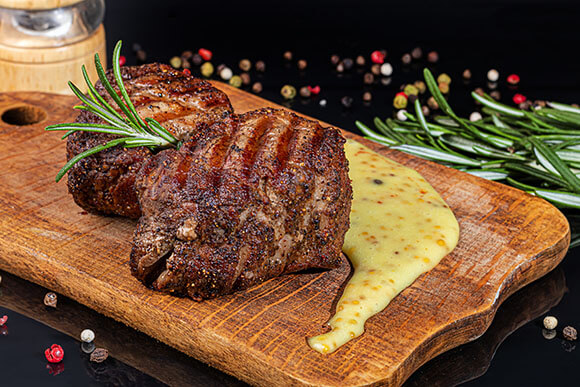
Also known as Filet Mignon, the Tenderloin steak is a luxurious and premium-cut option. Initially popularized in France, this halal steak is sourced from the cow’s loin and is highly esteemed for its exceptional tenderness. To cook this melt-in-your-mouth delicacy, pan-sear it and finish it in the oven for an exquisite medium-rare or medium doneness.
Filet mignon is an elegant cut known for its tender texture and subtle flavour. Season the steak with salt and pepper or your favourite seasoning blend. Preheat your grill or skillet on high heat. Sear the filet mignon for approximately 3-4 minutes on each side. For medium-rare doneness, cook the steak to an internal temperature of around 135°F (57°C). Rest the steak for a few minutes and serve.
Filet mignon is a premium cut of steak renowned for its tenderness, juiciness, and delectable flavour. Derived from the French term “cute or dainty fillet,” it is often considered the king of steaks and is highly sought after by meat enthusiasts and connoisseurs alike.
This coveted cut is hand-carved from the beef tenderloin, which is nestled within the loin region of the animal. The tenderness of the meat can be attributed to the fact that this particular muscle does very little work, resulting in a soft texture and melt-in-your-mouth experience.
The filet mignon is best known for its mouthwatering tenderness, making it an ideal choice for individuals who prefer juicy and tender steaks. It has a velvety texture with little fat marbling throughout, ensuring a buttery, almost silky, eating experience. The fine grain of the meat further contributes to its tenderness, allowing it to be easily cut and chewed.
In terms of flavour, filet mignon boasts a subtle yet distinct taste. It is often regarded as the most mild-flavoured of all steaks, with a delicate beefy essence that is not overpowering. This makes it an excellent canvas for complementing sauces, rubs, or seasonings, allowing it to absorb and enhance accompanying flavours.
Due to its reputation as an exquisite cut of meat, filet mignon is often associated with gourmet dining experiences and special occasions. It is commonly featured in high-end steakhouses and fine-dining establishments, where it is cooked to perfection by skilled chefs. The size of the filet mignon can vary, typically ranging from 6 to 8 ounces, though more significant portions can be found.
Numerous cooking techniques can be employed to prepare a filet mignon. Grilling is a popular method, offering a delicious smoky flavour while preserving the tenderness of the meat. Pan-searing is another commonly used technique that achieves a beautifully caramelized crust. Additionally, some prefer to wrap the filet mignon in bacon, enhancing its richness and adding a layer of juiciness.
Whether enjoyed on its own, paired with a classic béarnaise sauce, or accompanied by a medley of roasted vegetables, filet mignon is an indulgent culinary experience that satisfies even the most discerning palates. Its tenderness and subtle flavour profile make it a true delicacy that will impress and leave a lasting impression.
4- Halal T-Bone Steak

The T-Bone steak is a halal cut that combines the tenderloin and strip loaf flavours. Stemming from the United States, this steak is characterized by its T-shaped bone, which separates the two components. Achieving a perfect T-Bone steak involves grilling it to medium-rare or medium, ensuring each side is cooked evenly.
T-Bone steak combines a tenderloin and strip steak, making it a true carnivore’s delight. Begin by seasoning the steak with salt, pepper, and desired herbs. Preheat your grill or skillet on high heat. Sear the steak for 5-6 minutes on each side for medium-rare. Once cooked, let it rest for a few minutes before slicing and serving.
T-bone steak is a popular beef cut known for its distinctive T-shaped bone running through the center. It is derived from the short loin in the cow’s middle-back section. This particular cut of meat is widely appreciated for its tenderness, rich flavour, and impressive marbling.
The T-bone steak gets its name from the T-shaped bone that divides the meat into two distinct parts. On one side of the bone is the strip steak, also known as the New York strip, while the other side contains a portion of Tenderloin, known as the filet mignon. This combination is often called the best of both worlds, offering two different textures and flavours in one steak.
The strip steak, or the more significant portion of the T-bone, is tender, juicy, and well-marbled. It has a robust beefy flavour with a slightly firmer texture than the filet side. On the other hand, the filet mignon is incredibly tender and buttery and has a more delicate flavour profile. It is considered one of the most tender cuts of beef available.
The T-bone steak is best cooked using dry-heat methods such as grilling, broiling, or pan-searing. Its thickness and marbling ensure even cooking while retaining its juiciness and tenderness. Some prefer to season it with simple ingredients like salt and pepper to highlight the meat’s natural flavour, while others may marinate it for added flavour and tenderness.
When cooked to perfection, T-bone steak develops a beautiful crust on the outside while the inside remains succulent and tender. It is typically served medium-rare to medium, allowing the marbling to melt and release its rich beefy flavour. The textures and flavours on either side of the bone offer a delightful eating experience.
T-bone steaks are commonly enjoyed as a standalone dish, but they can also be complemented with various sauces, mushrooms, or compound kinds of butter like garlic butter. They can be paired with sides like roasted vegetables, mashed potatoes, or a fresh salad to create a satisfying and well-rounded meal.
5- Porterhouse Steak
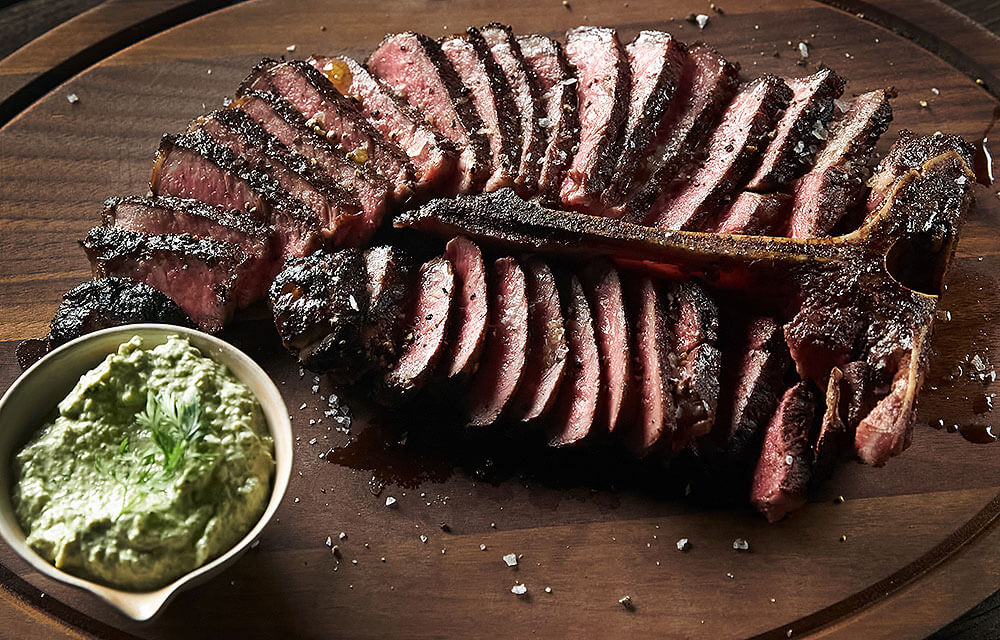
Like the T-Bone, the Porterhouse Steak is renowned for its large size and combination of Tenderloin and Strip Loin. This halal steak is distinguished by its significant portion of Tenderloin on one side of the bone. To cook a Porterhouse, the charring method works best. Sear both sides on high heat, then reduce the heat for longer, ensuring the meat is perfectly cooked.
Porterhouse Steak: Porterhouse steak is a generous cut that combines the filet mignon’s tenderness with the strip steak’s rich flavour. Season the steak with salt, pepper, and optional spices. Preheat your grill or skillet to high heat. Cook the steak for approximately 6-7 minutes per side for medium-rare. Allow the meat to rest before carving and serving.
Porterhouse steak is a premium cut of beef that is widely regarded as one of the most flavorful and tender steaks available. It is a popular choice among meat lovers who appreciate a hearty and indulgent meal.
The Porterhouse steak comes from the short loin of the animal, located just behind the ribs. This cut combines two steaks, the Tenderloin and the striploin, separated by a bone. The generous portion size usually ranges from 24 to 48 ounces, making it ideal for sharing or for those with a hearty appetite.
Its perfect balance of tenderness and flavour sets the Porterhouse steak apart. One side of the steak contains a large portion of Tenderloin, also known as filet mignon, which is highly valued for its melt-in-your-mouth texture. The other side consists of a striploin called New York strip steak, which offers a rich and robust beefy flavour. This combination gives diners the best of both worlds with a single cut of meat.
To prepare a Porterhouse steak, it is recommended to cook it using high-heat methods such as grilling or broiling. The thick cut allows for a seared and caramelized exterior while preserving the succulent and juicy interior. Seasoning with simple salt and pepper is often enough, as the meat’s natural flavours shine through effortlessly.
Serving a Porterhouse steak is an occasion in itself. The steak’s generous proportions and succulence demand attention and appreciation. It is often presented on a large platter, with the bone left intact to add a touch of elegance and richness to the overall appearance. Side dishes such as roasted potatoes, sautéed vegetables, or a fresh green salad perfectly complement the robust flavours of the steak.
Porterhouse steak is a meat lover’s dream, combining tenderness, flavour, and visual appeal into one unforgettable culinary experience. Whether enjoyed in a fine dining restaurant or cooked at home for a special occasion, this classic beef cut will satisfy even the most discerning palates.
6- Halal Flank Steak
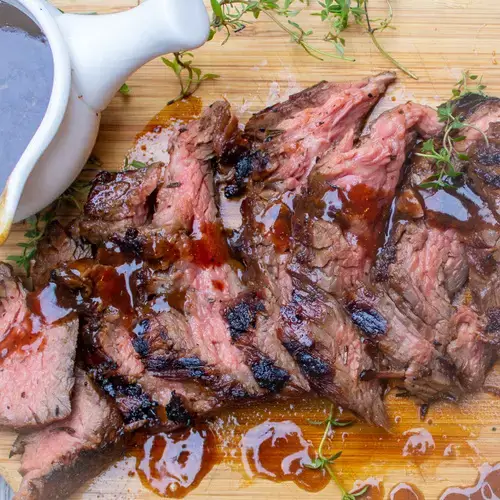
The Flank Steak is a flavorful halal option from Latin American cuisine. This lean and fibrous cut is best suited for marinating and grilling to achieve a mouthwatering result. Cooked to medium-rare, the flank steak is typically sliced against the grain for a tender and delectable experience.
Flank steak is a lean cut known for its bold and beefy flavour. Begin by marinating the steak to enhance its tenderness and taste. Preheat your grill or skillet on high heat. Cook the flank steak for approximately 4-5 minutes per side for medium-rare. Allow the meat to rest before thinly slicing it against the grain.
Flank steak is a delicious and versatile beef cut known for its rich flavour and tender, juicy texture. It is typically an extended, flat cut of meat that comes from the abdominal muscle of the cow.
To prepare flank steak, it is best to marinate it to enhance the flavour and tenderness. A simple marinade can consist of olive oil, soy sauce, garlic, lemon juice, and herbs and spices like rosemary, thyme, and black pepper. You can let the steak marinate for at least 30 minutes overnight in the refrigerator, allowing the flavours to penetrate the meat.
Before cooking, preheat your grill or stovetop pan on high heat. The high heat helps sear the steak’s outer layer and lock in the juices. You can also broil the flank steak in the oven for about 5-7 minutes on each side, depending on your desired level of doneness.
Once the steak is cooked, rest for a few minutes before slicing it against the grain. Cutting against the grain ensures the steak remains tender and easy to chew. Flank steak is often served thinly sliced, making it perfect for stir-fries, fajitas, sandwiches, or salads.
Flank steak pairs well with various side dishes such as roasted vegetables, mashed potatoes, or a refreshing garden salad. You can also add a sauce or glaze, such as chimichurri or a red wine reduction, to enhance the flavours further.
Flank steak is a popular choice for beef lovers due to its bold taste and versatility in different dishes. With the suitable marinade and cooking technique, you can enjoy a delicious and juicy flank steak that will leave your taste buds craving more.
7- Halal Hanger Steak
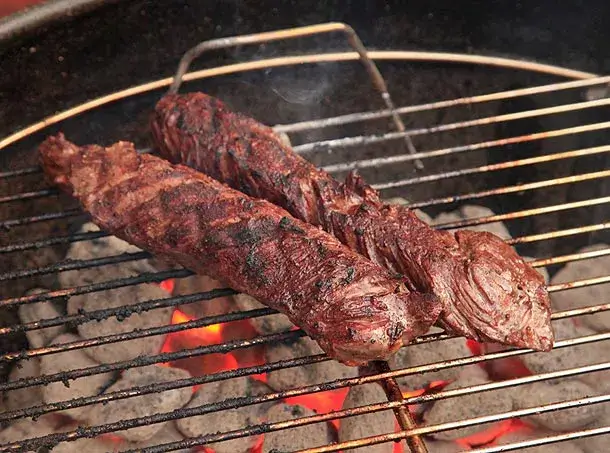
Also known as Onglet, the Hanger steak is a lesser-known halal cut that has recently gaining popularity. This steak is sourced from the diaphragm muscle and offers robust flavours and a unique texture. Marinating the hanger steak before grilling or pan-searing is vital for tenderizing the meat and enhancing its taste.
Hanger steak, also known as butcher’s steak or hanging tender, is a flavorful and tender cut of meat derived from a cow’s diaphragm muscle. Despite not being as well-known or popular as other cuts like Ribeye or filet mignon, hanger steak has gained a loyal following among culinary enthusiasts, chefs, and meat lovers for its deep flavour and unique texture.
The name “hanger steak” originates from the fact that this cut is used to hang from the cow’s diaphragm, supporting its internal organs. It is a relatively long and flat muscle, shaped like a hanging “V,” with a distinct grain and a pronounced tendon running through its center. This tendon, which should be removed before cooking, gives the steak its unique shape and texture.
One of the reasons why hanger steak has become so cherished is because of its intense beefy flavour. It has a rich, almost buttery taste that is often described as similar to flank steak but with a more pronounced umami essence. The open texture of the meat, combined with its marbling and fat content, contributes to its exquisite taste and juiciness.
When cooking hanger steak, it is best to keep it simple to allow its natural flavours to shine. Due to its tender nature, it doesn’t require a lot of additional seasoning or marinades. A popular cooking method for hanger steak is grilling or pan-searing it to medium-rare or medium doneness. This helps to preserve its moisture and tenderness while also developing a beautiful caramelized crust on the outside.
Hanger steak is also versatile and can be used in various dishes. It can be sliced and used for stir-fries, fajitas, or even as a steak sandwich. The bold flavour of hanger steak also pairs well with robust sauces, such as chimichurri or red wine reduction, further enhancing its taste.
Another factor that adds to hanger steak’s appeal is its relative affordability compared to other premium cuts of meat. While still considered a specialty cut, it is often priced more reasonably, making it an attractive option for those who want to enjoy a delectable steak without breaking the bank.
8- Halal Skirt Steak
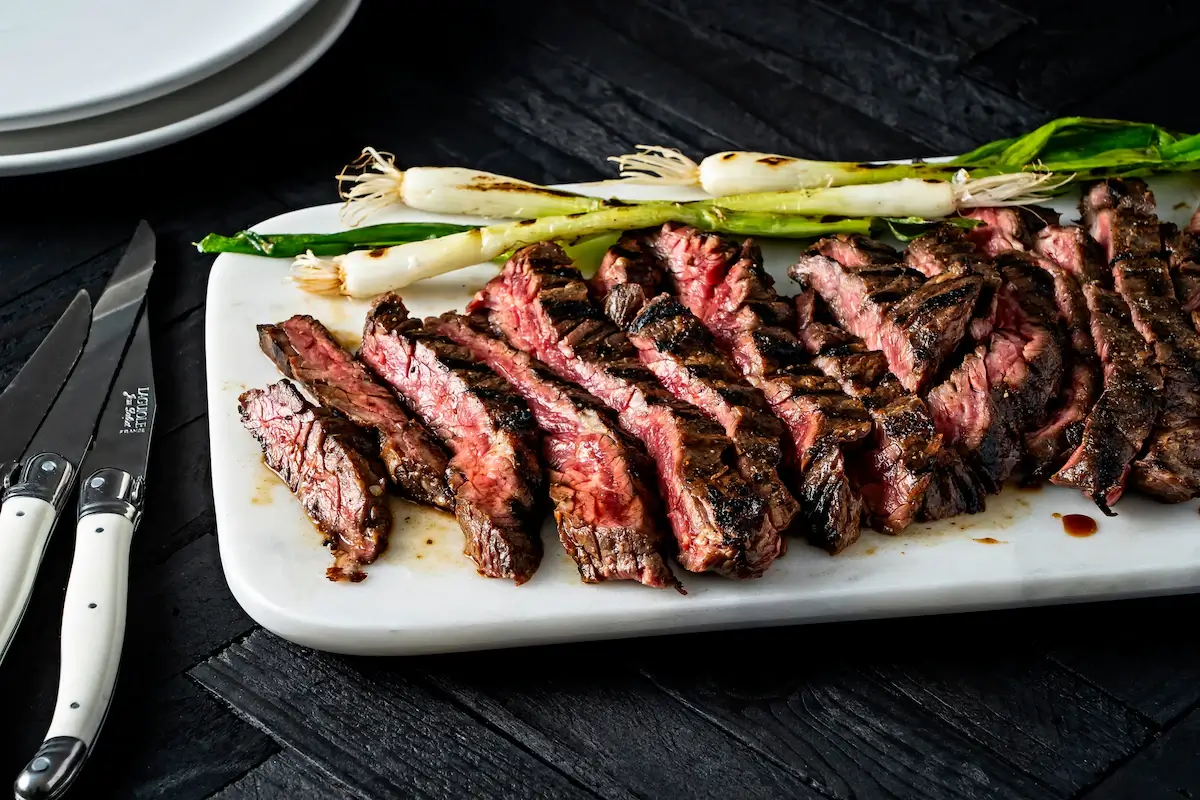
Skirt steak is a thin, flavorful cut perfect for grilling or pan-searing. Marinate the steak in your choice of seasonings for at least 30 minutes or overnight for more flavour. Preheat your grill or skillet on high heat. Cook the steak for about 2-3 minutes per side for medium-rare. Let it rest for a few minutes before slicing it against the grain.
Skirt steak is a flavorful and versatile cut of beef that has gained popularity in recent years. Also known as fajita steak or Philadelphia steak, it comes from the diaphragm muscle of the cow, specifically from the plate section. The unique texture and rich flavour of skirt steak make it an excellent choice for grilling, searing, or marinating.
Skirt steak is renowned for its long, flat shape and coarse grain structure. It is relatively lean compared to other cuts, with some fat marbling throughout, contributing to its tenderness and juiciness when appropriately cooked. The meat is known for its bold, beefy flavour that pairs well with various seasonings, marinades, and sauces.
One of the reasons skirt steak has become increasingly popular is its versatility. It can be used in a wide range of dishes and cuisines. Skirt steak is a staple in Mexican cuisine, commonly used in fajitas, tacos, and carne asada. Its tender yet robust texture makes it perfect for grilling, as it can handle high heat and develop a nice char while remaining juicy and flavorful.
In addition to Mexican cuisine, skirt steak is often utilized in other dishes such as stir-fries, sandwiches, salads, and even Korean barbecue. It is also famous for steak lovers who prefer a more economical cut without sacrificing taste and quality.
When cooking skirt steak, it is crucial to properly marinate or season the meat to enhance its flavour and tenderize the muscle fibres. Aki’s recipe for skirt steak at home involves marinating the steak in a mixture of soy sauce, garlic, lime juice, and various spices for at least 30 minutes. This allows the flavours to penetrate the meat, producing a delicious and well-seasoned steak.
Using high-heat methods such as grilling, broiling, or pan-searing is best for cooking skirt steak. Due to its thinness, skirt steak cooks relatively quickly, usually within 3-5 minutes per side, depending on the desired level of doneness. It is recommended to cook it to medium-rare or medium, as overcooking can lead to a more rigid texture.
Skirt steak is popular among enthusiasts and chefs due to its excellent flavour, affordability, and versatility. Whether you’re looking to enjoy a sizzling plate of fajitas or a mouthwatering steak sandwich, skirt steak’s bold taste and tender texture are sure to satisfy.
Difference between halal meat and regular meat
Halal and regular meat are distinct categories based on production and preparation methods. Understanding the differences between these two types of meat is important for individuals who follow specific dietary practices or have cultural or religious considerations.
As the Quran outlines, according to Islamic law, halal meat refers to permissible food. The term “halal” means “permissible” in Arabic. Halal meat comes from animals that have been raised, slaughtered, and processed following specific guidelines. These guidelines include ensuring the animal is healthy, using a sharp knife to swiftly sever the major blood vessels in the neck while reciting a prayer, and allowing all blood to drain from the body. Also, halal meat must not come into contact with non-halal substances during processing.
On the other hand, regular meat refers to meat that does not adhere to specific religious or cultural dietary restrictions. It may be sourced from animals not subject to particular guidelines during rearing or slaughter. Regular meat can be found in various forms, such as beef, pork, poultry, and seafood.
The key difference between halal and regular meat is their preparation methods and adherence to specific religious or cultural requirements. For individuals who follow Islamic dietary laws or prefer halal options for personal reasons, consuming halal-certified meats ensures compliance with their beliefs.
It’s worth noting that while halal certification ensures compliance with Islamic dietary laws, it does not guarantee factors such as animal welfare standards or the overall quality of the product. These aspects may vary depending on individual suppliers and regulatory bodies overseeing food production.
In summary, halal meat refers to food prepared according to Islamic dietary laws, while regular meat encompasses all other types of non-specifically prepared meats. Understanding these differences allows individuals with specific dietary requirements or preferences to make informed choices when selecting food sources.
What is hanger steak called in Canada?
Hanger steak is a popular cut of beef known for its rich flavour and tenderness. In Canada, it is commonly referred to as “onglet” and is considered the “butcher’s cut.” This delicious meat comes from the animal’s plate or lower belly area.
Although hanger steak is commonly used in the United States, Canadian butchers and meat purveyors use “onglet” to describe this cut. Onglet or hanger steak is highly prized for its unique texture, delicious marbling, and rich, beefy flavour. It is a favourite among steak enthusiasts and culinary professionals.
If you’re shopping for onglet in Canada, you can find it at local butcher shops, high-end grocery stores, or specialty meat markets. These establishments often carry a wide selection of quality cuts, including onglet. By asking your local butcher or meat expert for onglet, they will be able to recognize it and provide you with the best recommendations for cooking and preparation.
Onglet can be cooked to perfection and enjoyed in various culinary preparations, whether grilling, searing, or marinating. Its robust flavour pairs well with bold seasonings or marinades, making it a versatile choice for steak recipes. From classic steak frites to Asian-inspired stir-fries, Onglet can add a delicious touch to your culinary creations.
What is skirt steak called in Canada?
Skirt steak is a popular cut of beef in North America. In Canada specifically, it is often referred to as “faux-filet.” While in the United States, the term “skirt steak” is more commonly used. The French-influenced term “faux-filet” is adopted by Canadian butchers and meat purveyors to describe this flavorful cut of beef.
Faux-filet, or skirt steak, is a long and thin cut of beef taken from the animal’s plate or lower belly area. It is known for its robust flavour and texture due to the significant marbling and long, parallel muscle fibres. Skirt steak has a slightly coarse texture that contributes to its rich flavour profile.
You can find faux-filet or skirt steak in Canada at local butcher shops, high-end grocery stores, or specialty meat markets. These establishments typically offer a variety of quality cuts, including faux-filet. To get the best recommendations for cooking and preparation techniques, ask your local butcher or meat expert for faux-filet.
Faux-filet, or skirt steak, is a versatile cut that can be prepared in various ways to suit different culinary preferences. Latin American cuisine often uses it for fajitas, tacos, or carne asada. The intense flavour of faux filet pairs well with bold seasonings and marinades, making it a popular choice for grilling or pan-searing. It is important to note that skirt steak is best when cooked quickly at high heat to retain its tenderness and juiciness.
Whether you’re planning a barbecue, a Mexican-inspired feast, or experimenting with global flavours, faux-filet or skirt steak, it is a fantastic choice that delivers on taste and texture. Its distinct beefy flavour and versatility make it a favourite among meat enthusiasts and chefs.
If you’re in Canada and looking for a delectable cut of beef, seek out “faux-filet” or skirt steak. With its robust flavour, marbling, and versatility, faux-filet will elevate your culinary creations and satisfy your taste buds.
What type of steak is halal?
Halal refers to food that is permissible according to Islamic dietary laws. Regarding steak, the type of meat considered halal depends on certain criteria.
Generally, any steak that comes from a halal-certified source and meets the requirements of Islamic dietary laws can be considered halal. This means that the animal from which the steak is sourced must have been explicitly slaughtered, following Islamic guidelines.
Typically, halal steaks are made from beef or lamb. The specific cuts of meat can vary depending on personal preference and cultural traditions. However, it is important to ensure that the animal has been slaughtered by a Muslim who has pronounced the necessary prayers and performed the required actions during the slaughter process.
To ensure that you are consuming halal steak, it is advisable to look for reputable halal-certified suppliers or restaurants that adhere to strict halal standards. This way, you can enjoy your steak while sticking to your dietary requirements.
How do you know if steak is halal?
Determining whether a steak is halal or not requires some understanding of the halal certification process and specific guidelines followed by Muslim communities. Here are a few key points to consider when determining if a steak is halal:
1. Halal Certification: Look for the halal certification label on the packaging or inquire about the source of the meat. This certification ensures that the entire process, from slaughter to packaging, adheres to Islamic dietary laws.
2. Slaughter Method: In Islam, animals must be slaughtered following specific guidelines. The animal should be alive at the time of slaughter and must be slaughtered by a Muslim who recites a prayer (known as dhabiha) while cutting the throat swiftly to ensure minimal pain.
3. Source Verification: If you are unsure about the halal status of a steak, it’s best to verify its source with reliable sources such as reputable halal certifying organizations, trusted suppliers, or Islamic centers in your area.
4. Cross-Contamination: Ensure that non-halal meats are not mixed with halal meats during storage, preparation, or cooking processes, as this can compromise its halal status.
5. Halal Restaurants: If you are dining out and want to enjoy a halal steak, look for restaurants that explicitly mention their adherence to Islamic dietary guidelines or have obtained halal certifications from recognized authorities.
It’s important to note that practices may vary among different countries and regions due to cultural differences and interpretations of Islamic dietary laws. Therefore, it is always recommended to consult with knowledgeable individuals or organizations within your community for accurate information regarding halal food options.
- Yonge-Dundas Square in Toronto is Now Called “Sankofa Square” - December 17, 2023
- Best Western Brooks’ SureStay Plus debuts in Alberta - December 16, 2023
- Air Canada Arrives in Tulum, Mexico as the First Canadian Airline - December 16, 2023




